Roi Soleil Barge Cruise Review
By Karl Zimmermann
“Luxe, calme et volupté” is the refrain in a work by nineteenth-century French poet Charles Baudelaire titled “L’Invitation aux Voyage.” Into English that translates as “luxury, peace and exquisite pleasure.” This phrase rang a bell for my wife Laurel and me.
We were among six passengers, three cabin’s-worth, a full house, aboard the Roi Soleil barge cruise, the Sun King, for six lovely nights in mid-April on the Canal du Midi in Southern France.
The Roi Soleil is a “river barge” — what it’s actually called, though that does seem a misnomer for a vessel so elegant and luxurious — among a large handful that sail for Barge Lady Cruises, mostly in France with a few itineraries in the U.K. and Ireland and Central Europe.

In Le Somail, we had the chance to visit three other barges that are part of the Barge Lady fleet. This is Elegance and the blue-hulled barge aft of it is Esperance. * Photo: Karl Zimmermann
Four Hands on Deck
We dined like queens and kings, courtesy of chef Toby, a Brit now based in the French Alps. “That’s the best food I ever ate,” says Laurel, a dedicated foodie and quite a cook herself. We soaked up local history on daily outings led by our tour guide, the knowledgeable and irrepressible Becky, who was invariably attentive to the wishes and needs of all of us.

Chef Toby is making lobster tortellini at the prep table. We passengers were always welcome to watch Toby at work but in this case he had issued a special invitation. * Photo: Karl Zimmermann
We savored our time cruising under the sure hand of Seppe, our pilot, who steered us in and out of locks and through bridges of mind-boggling constriction. And we were pampered by Aiste, our hostess, from Lithuania and now based in Portugal, a Jill of many trades and mistress of all.
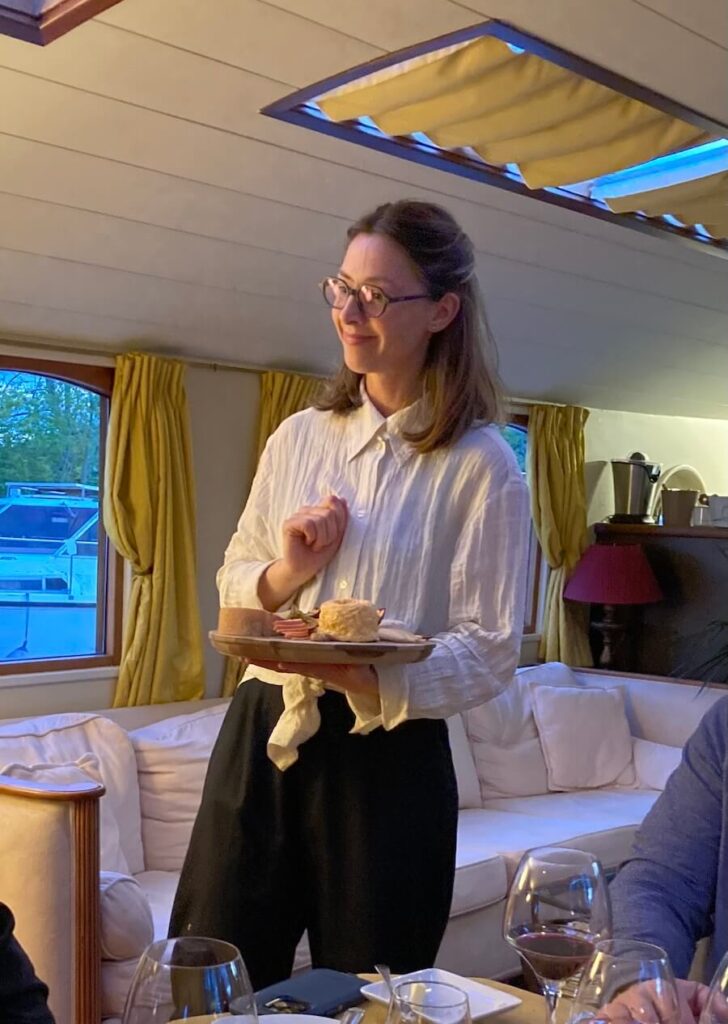
Hostess Aiste is explaining the particulars of the night’s cheese course. She also sometimes introduced the wines, a role most often taken by tour guide Becky. * Photo: Karl Zimmermann
The geniality and expertise of this quartet were a daily delight as we watched them cross job descriptions and pitch in wherever needed, always with an eye toward making us passengers comfortable and happy.

The entire crew gathers around the work table as Toby prepares a starter. Becky is at the left and pilot Seppe is at table end. * Photo: Karl Zimmermann
“The crew are as collaborative as the most exquisite jazz ensemble,” Laurel would write in the comment book at journey’s end, “playing their solos to perfection but joining the others intuitively to make brilliant music together.”

Aiste tosses a line to Toby as we prepare to tie up for the night—a good example of the crew’s pitching in on any task at hand. The “no parking” sign reflected the fact that this spot was reserved for us. * Photo: Karl Zimmermann
Subscribe to our monthly small ship cruise email
Subscribe to QuirkyCruise.com for monthly curated newsletters highlighting our top small cruise ship reviews, round-ups & offers!
A Canal with a Past
The Canal du Midi is a waterway rich in history, a true pioneer, a UNESCO World Heritage Site, fully watered on May 19, 1681. It was part of a dream of connecting the Mediterranean Sea and the Atlantic Ocean that was as old as the Roman Empire. (When completed, the “Canal of the Two Seas” network included, along with the Midi, the Brienne, Junction, Robine, and Garonne Lateral Canals.)
The Midi was seminal, so much so that Thomas Jefferson came to check it out with the Erie Canal project still ahead, and got a bridge named for him in Le Somail. In this historic canal town, where barges paused long ago for provisions that included ice brought down from the nearby Black Mountains, we rendezvoused with passengers from three other Barge Lady boats that happened to be in the area.

This is the Thomas Jefferson Bridge in the historic canal port of Le Somail. It commemorates Jefferson’s visit to the Canal du Midi to learn what he could for the building of the Erie Canal, which was surveyed beginning in the final year of his second term as President of the United States. * Photo: Karl Zimmermann
Hosted by the company’s self-described “Marketing Maven” Stephanie Sack who was sailing on one of the other barges, we sipped apéritifs at a canalside café and chatted about the town’s capacious temple to reading, La Librairie Ancienne du Somail, the world-class bookstore we’d just visited.

Part of the remarkably extensive interior of La Libraire Ancienne du Somail. As a bibliophile I felt embraced, though virtually all of the books are, of course, in French. * Photo: Karl Zimmermann
Posh Life in the Slow Lane
On our mosey from Homps to Portiragnes, we made four kilometers per hour, appropriate for a boat of our size and stature though the canal speed limit was eight.
(Getting to and from the canal from Paris, we used the high speed TGV, the Train à Grande Vitesse, which at one point touched 300 k/hr. I privately dubbed our barge, in my fractured French, the “bateau sans vitesse,” and loved it for that.)

One of the aqueducts we transited is this one in Béziers, over the River Orb. Béziers is the birthplace of Pierre-Paul Riquet, the designer of the Canal du Midi. * Photo: Karl Zimmermann
Aboard Roi Soleil, we crossed viaducts over rivers and experienced two of Canal du Midi’s engineering marvels, conceived by its designer, Pierre-Paul Riquet: Malpas Tunnel to pierce a hill it couldn’t circumnavigate and the Fonserannes staircase of seven locks (eight originally).

Becky is sitting on the foredeck with a basket of stale bread as we approach the Malpas Tunnel. In it, she explains, is a hermit, and passing boats are encourages to throw bread into his home to feed him. Bread is also used by the crew to chum for the huge catfish (I never saw any) that live in the canal. * Photo: Karl Zimmermann
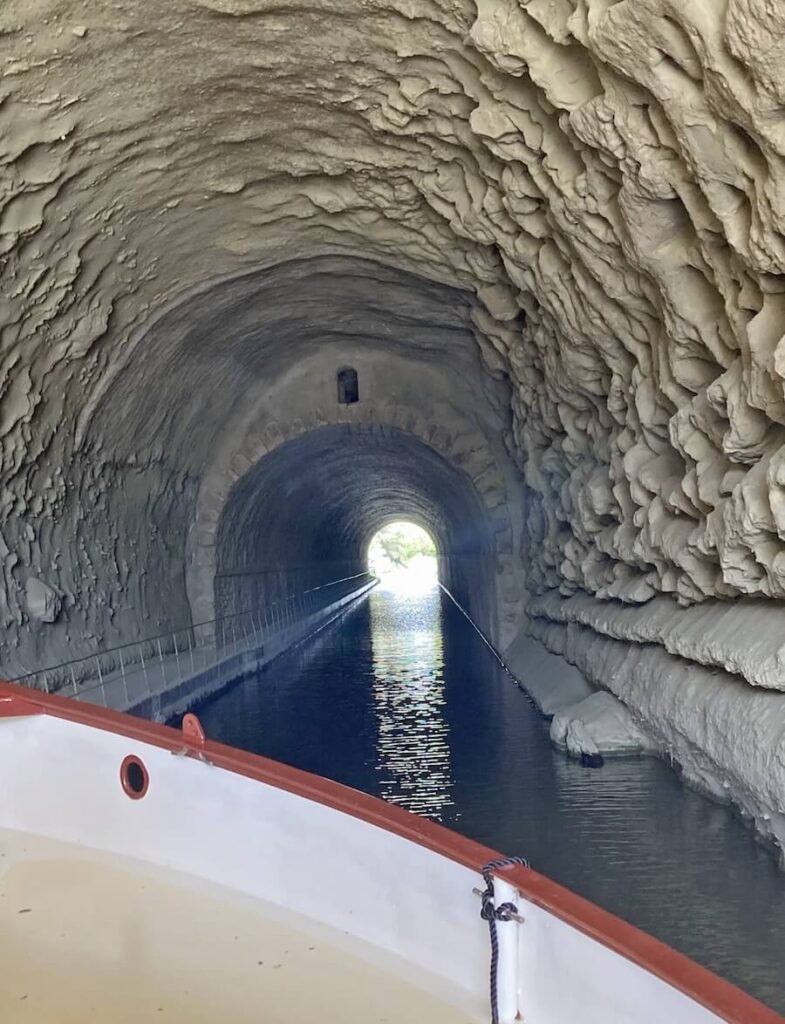
Inside the tunnel through Malpas Hill, with a view of the hermit’s home. Though many of us tried our luck, Corey McPherrin was the only one to hit the bull’s eye. News and, before that, sports anchor on Chicago television, retired since last August, Corey attributed his success to his practicing before taking the mound to throw the first pitch at a Chicago White Sox game. * Photo: Laurel Zimmermann
Many lock chambers along the canal are oval rather than the typically rectangular, a conceit of Riquet’s as an expedient to reduce pressure. Though this design didn’t survive the test of time, it intrigues canal buffs like me, as do the foursquare, tile-roofed, pastel-painted lock-keeper’s houses that survive, though the keepers today, who operate most of the locks from “belly packs,” no doubt are commuters.

Here Becky wears the lines like a necklace at the Fonserannes Lock Staircase, moving from lock to lock. She often facilitated locking through by running ahead to be ready to handle lines when we arrived. When navigating though locks, Seppe would move to the exterior wheel, where he also had access to throttle and bow thruster. * Photo: Karl Zimmermann

Oval locks were Pierre-Paul Riguet’s conceit, thinking they would make the walls more pressure-resistant. The idea didn’t catch on, but many of these historical anomalies survive on the Canal du Midi. * Photo: Karl Zimmermann
A Barge with a History
The Roi de Soleil was born in 1924 as the Stern, a freight barge. A photo album aboard chronicles its transformation 24 years ago from this unremarkable freighter into the luxury “River Yacht,” so marketed by its owner and on the crew’s shirts, that it is today. (A picture of the old barge with the name “Stern” emblazoned across its bow provided a chuckle.)

Our beautiful barge began life in 1924 as the freighter Stern, an anomalous name when seen painted on the bow. “Stern” is German for “star,” which could explain the name. * Photo: Karl Zimmermann
As built the boat was 38 meters long. The first step in turning this sow’s ear into a silk purse was to shrink its length to 30 meters, the maximum the lock chambers can accommodate.
Little of the original craft survives but the hull, but that’s a detail important to me, as its graceful, sweeping “sheer” gives the Roi Soleil a nautical cred lacked by the other hotel barges we encountered, which can look like floating patios with umbrellas.

Freighting on the canal ended in 1989, but there were survivors, some rust buckets listing into oblivion, others modified into makeshift homes, all evocative of another era. However, Seppe believes an entrepreneur was currently trying to revive freighting in a modest way. * Photo: Karl Zimmermann
RELATED: Heidi reviews her week aboard the 12-pax Luciole on the Nivernais Canal.
RELATED: The Esperance is reviewed by Elysa Leonard.
RELATED: 10 Barge canal cruises in France to consider.
The Deck Plan of the Roi Soleil Barge Cruise
From stem to stern, this is the Roi Soleil. Forward is an open deck with six comfortable chaises, the place to see the sights when under way.

Back from a tour of Carcassonne, Tracy O’Brien, a Barge Ladies veteran and TV producer in Chicago, and Laurel relax on the forward deck before lunch. With one exception, we spent the nights moored in sylvan spots such as this. * Photo: Karl Zimmermann
Behind that is the wheelhouse, Seppe’s domain, but a comfortable love seat makes it a welcoming spot for drop-ins.

The wheelhouse was my favorite spot. “You never stop steering,” said Seppe, at the wheel here as always, and indeed the wheel is in constant motion, back-and-forthing to keep this heavy vessel on course. Cory Brown is the other visitor with me and Toby is out chatting with Tracy and Corey. * Photo: Karl Zimmermann
Behind that is the main cabin, really the barge’s great room.

The barge’s “great room” is spacious and airy and has a nautical feel. * Photo: Karl Zimmermann
Right behind the wheelhouse are stairs leading down to the passenger cabins. In the great room there’s a dining table, a sofa, and a long counter where breakfast buffets were laid out each morning and nibbles in the afternoon.

More often than not meals were in this comfortable inside setting, as our trip was ahead of the main sailing season on the canal and the weather was often too chilly for outdoor dining. Dinners featured a variety of creative napkin-foldings, this one with a floral twist. * Photo: Karl Zimmermann
Behind that is the open kitchen, where we were welcome to kibitz with Toby as he went about his magic.

A typical serving from the breakfast buffet: cheeses, fruits, and pastry, which a member of the crew fetched each morning from a local patisserie. * Photo: Karl Zimmermann
Aft is a canvas-shaded deck with a triangular table where meals were served when weather permitted, which it didn’t always.

The triangular table aft was the lunch and dinner venue of choice, weather permitting. Here it is set for our final luncheon. * Photo: Karl Zimmermann
Some days were windy and temperatures ran below those forecast, though that rarely kept us off the forward deck, since Aiste would bring us the blankets that I think of as “steamer rugs.”

Weather this last afternoon on board is menacing, but we’re on deck enjoying the final miles. Much of the canal was once lined with plane trees, but a blight killed most of them and replanting using a variety of species is evident in places. * Photo: Karl Zimmermann
Cleverly hidden on the aft deck beneath two chaise longues when not in use is a hot tub.

Cory Brown is enjoying his morning coffee in the hot tub. * Photo: Karl Zimmermann
The below-deck staterooms are perhaps a small price paid for the bright commodiousness of the main cabin above. The only natural light comes from small opening skylights where wall meets ceiling. Some hotel barges have cabins with regular windows, but ours were comfortable and attractively decorated, with spacious bathrooms en suite, and anyway who wouldn’t rather be up on the open decks, in the main cabin, or in the wheelhouse?

Our comfortable cabin, one of three, lacks a view, but views abound indoors and out on the deck above. A spacious bathroom is en suite. * Photo: Karl Zimmermann
From the Beginning
Our adventure began at the railway station in Narbonne, not far from the Mediterranean, where Becky met us in a Mercedes van, which would be our wheels throughout the cruise, and shuttled us to Homps, where our barge and the rest of the crew awaited us.
Becky was everywhere, a wonderful, perky, elfin presence on and off the boat: driver, tour guide, interlocutor, sommelier, handler of lines as we made our way through locks. She grew up in England, near Bristol, and recently bought a house in the Midi, mortgage-free, with the money she’d saved working for a decade on the Alouette, a hotel barge operated by the Orient Express company.

In Le Somail we ease past the Alouette, the barge on which Becky had worked for the previous decade. She’s aboard visiting old friends. * Photo: Karl Zimmermann

Toby is handing Becky pastries to share with the lock keepers at Ecluse de l’Orb, the next lock past the Fonserannes Staircase, in Les Ports Béziers Méditerranée. At the end of the day Becky drove an interested few of us to see the Med, which surprised us with its proximity. * Photo: Karl Zimmermann
After introductions, bubby, and snacks, Seppe headed to the wheelhouse.
We had our first taste of canal-cruising life, encountering immediately an écluse, or lock, always an event for me: the closing of the leaves of the mitre gate behind us, the cascading, fragrant rush as water equalizes, and finally the majestic opening of the gate ahead as Seppe notched the throttle and Roi Soleil went on its way.
“Every time this canal takes a turn the landscape changes,” Seppe would tell me later. “That’s why I love the Canal du Midi. After a dozen years I still enjoy the excitement of the locks and bridges.” He grew up in Belgium, near Antwerp, worked for a time as a boat builder, and now lives a stone’s throw from the canal.

Voyage map. * Image: Karl Zimmermann
And Then, What a Dinner!
That first night of our Roi Soleil barge cruise, as would be the norm, there were starter, main, cheese, and dessert, and two wines. Becky introduced the wines (Albarino, Laurent Miquel 2021, and Eos, Domaine Laguerre 2022).

Fine wines were central to the Roi Soleil experience as we barged through the Languedoc, and on this occasion, we tied up right by a vineyard. * Photo: Karl Zimmermann
Toby detailed the courses — pan seared scallops, cauliflower puree, charred cauliflower, bacon dust and curry oil, followed by quail ballotine with morel mushroom, sweetcorn puree, brocolini with a mushroom jus and pickled mustard, ending with rosemary pannacotta with an olive oil sponge, spiced cherries and honeycomb tuile.
Before that Aiste slipped in to explain the evening’s three cheeses (Fromage d’Ambert, Rocamadour, Comte).

This was the starter for our Farewell Dinner: home cured salmon and pickled cucumber. The wine accompaniment was L’Intendu, Clos du Gravillas, 2022—local, like most we were served. * Photo: Karl Zimmermann
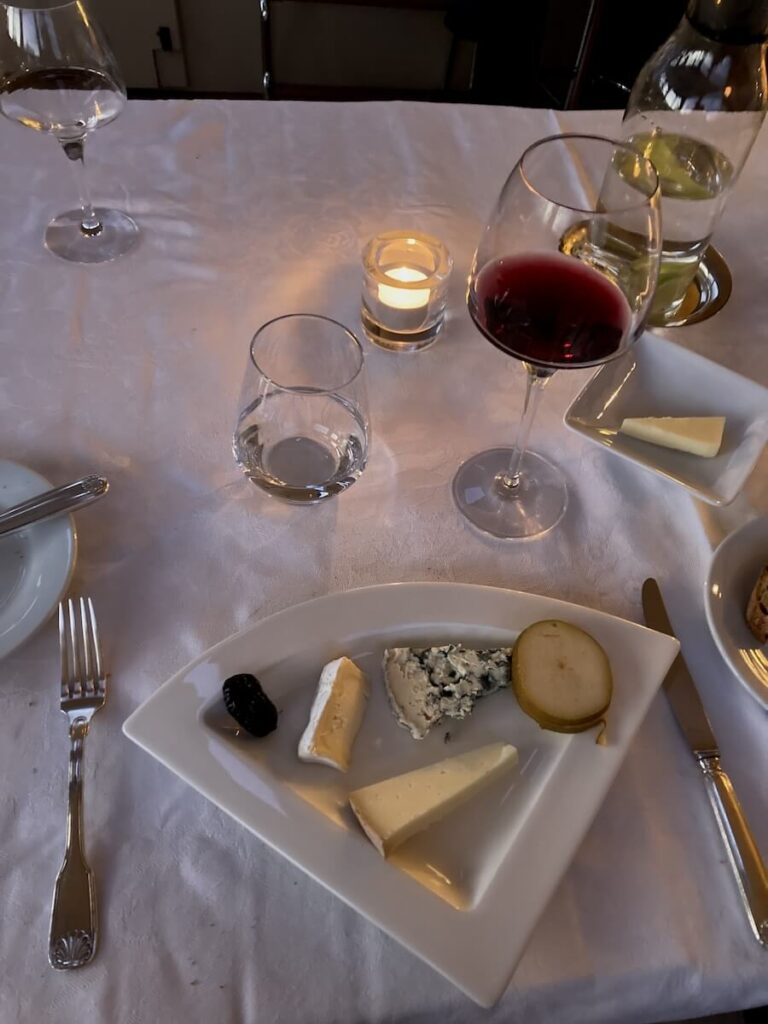
A typically enticing cheese course, a part of every dinner. * Photo: Karl Zimmermann
Luncheons skipped the cheese course and served a single wine. Breakfast buffets offered meats, cheeses, and fruits, plus an array of breads and pastries that a member of the crew acquired daily at a local patisserie while we passengers were still abed.
For me the highlight was always a glass, maybe two, of jus d’orange pressée, fresh as the morning. There was one luncheon off the boat, in Narbonne, and one dinner, at Au Lavoir, a fine restaurant in Colombiers; both would have been highlights had not Toby been Toby. He claimed to be a self-taught chef, but if so he had an excellent instructor.
A Daily Tour, Then Time on the Canal Each Day
Typically Becky would take us off on a morning excursion, and the first was a tour of the walled city of Carcassonne, holding a substantial contemporary town within, with shops and restaurants. Becky narrated the fortress’s 2600-year history, including the influence of the bloody Cathars, a religious sect, but as a shutterbug I enjoyed as much making images: the cathedral’s stained glass, the winding streets.

Led by Becky, our group begins its tour of the walled city of Carcassonne. * Photo: Karl Zimmermann
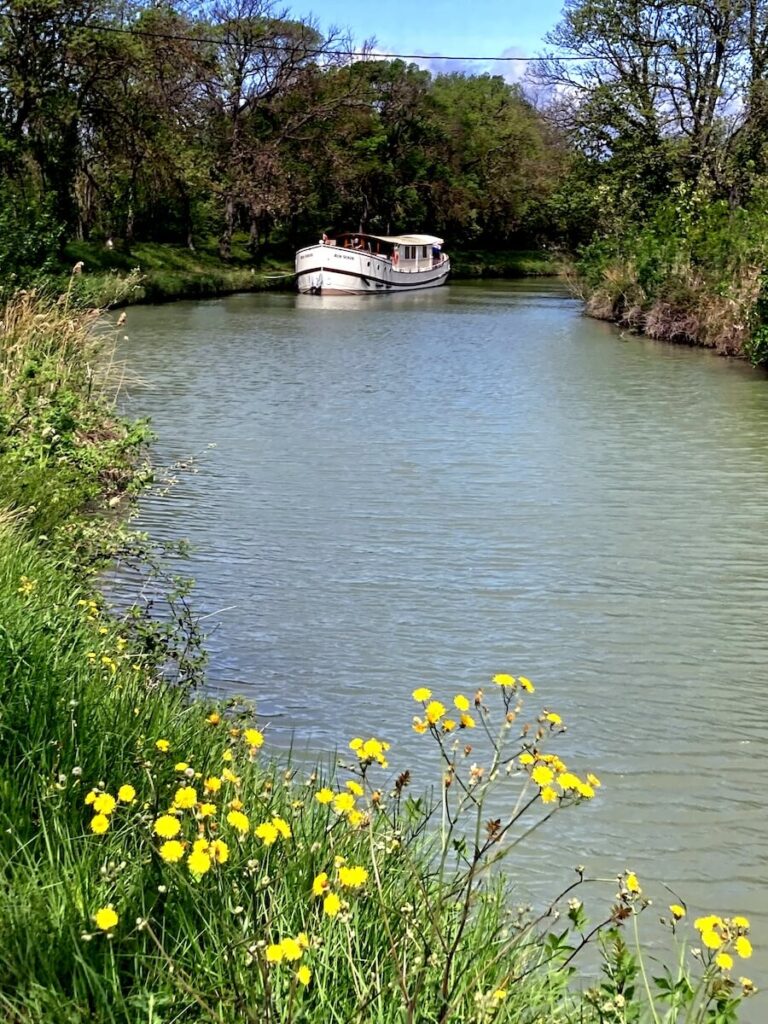
Driving back to the barge after our Carcassonne tour, I spotted this rural image, so typical of our voyage. * Photo: Karl Zimmermann
Our day-two tour began with a visit to L’Ouibo, a cooperative olive-oil mill, where we were guided through the process of picking, selecting, and pressing the olives, and learned what defined the coveted “extra-virgin.”

The first part of our tour of L’Oulibo olive mill was this demonstration of the picking of the prime olives, destined to be pressed into extra virgin oil. * Photo: Karl Zimmermann
From there we went to Minerve, another walled city with a lively contemporary village of a few hundred residents within, thought to be among “Les Plus Beaux Villages de France.” Wisteria was everywhere.
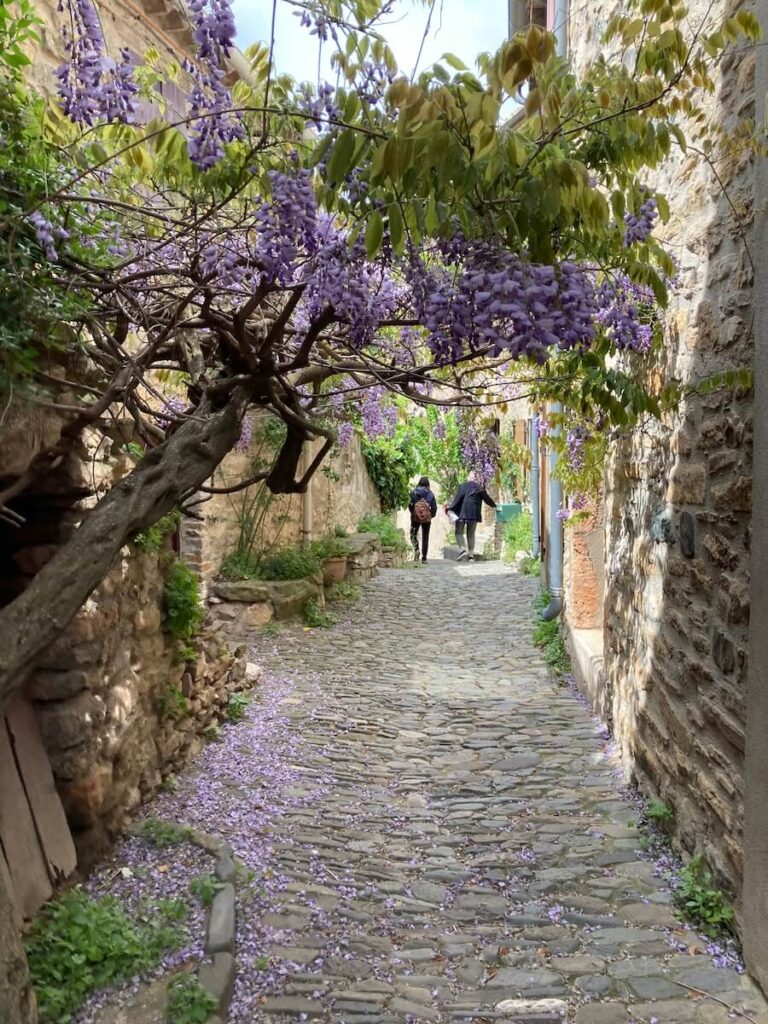
Laurel and Becky walk down a cobbled alley in Minerve. * Photo: Karl Zimmermann
Laurel and I chose to sit out the last segment of a strenuous walk to patronize “Paroli, Librairié, Salon de thé.”
At the proprietor’s desk for sale, .60 euros, were “Madeleines de PROUST!”

In Minerve, Paroli: Librairié, Salon de thé, purveyor of Madelaines. * Photo: Karl Zimmermann
Toby offered madeleines one evening, along with a crème brûlée. The Canal du Midi was a perfect place for remembrance of things past.
Narbonne, L’Abbaye de Fontfroid, and Pézenas
The next day brought a tour of Narbonne, including lunch, back to where we’d started and would end up, proof that as the crow flies we didn’t travel too far on our barge though experiences on and off the canal were manifold.
The abbey, a Cistercian monastery, had been founded near the end of the eleventh century by Benedictine monks, drawn there, as the name suggests, by access to fresh, cold water.
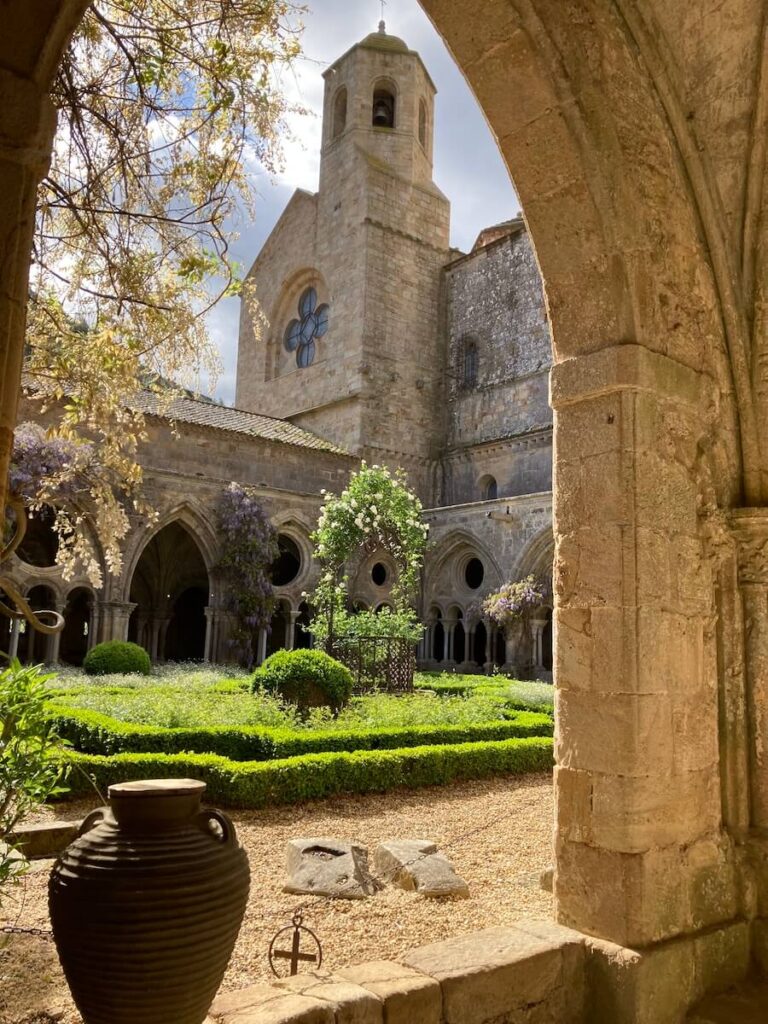
The courtyard of l’Abbaye fe Fontfroide. * Photo: Karl Zimmermann
After a long history, in 1908 two artists, Gustave and Madeleine Feyet-d’Andoque acquired it and much of the art there dates from their era. The church, the cloisters, the terraced garden are all irresistibly photogenic.

We were just ahead of the peak season on the Canal du Midi, and had a more peaceful voyage that we might have had later when this armada of rental boats, one of two I spotted along the way, sailed. * Photo: Karl Zimmermann
The last day was an appropriate coda, my favorite of the cruise. Flopping the usual pattern, we sailed in the morning, bright and crisp, down the Fonserranes staircase of locks.

Going down the Fonserranes staircase of locks. * Photo: Karl Zimmermann
That afternoon, our final tour was to Pézenas. Dating from the thirteenth century, it was once the royal town of Louis IX and remains a charming small city of narrow, twisting streets and historic buildings, many housing upscale shops.
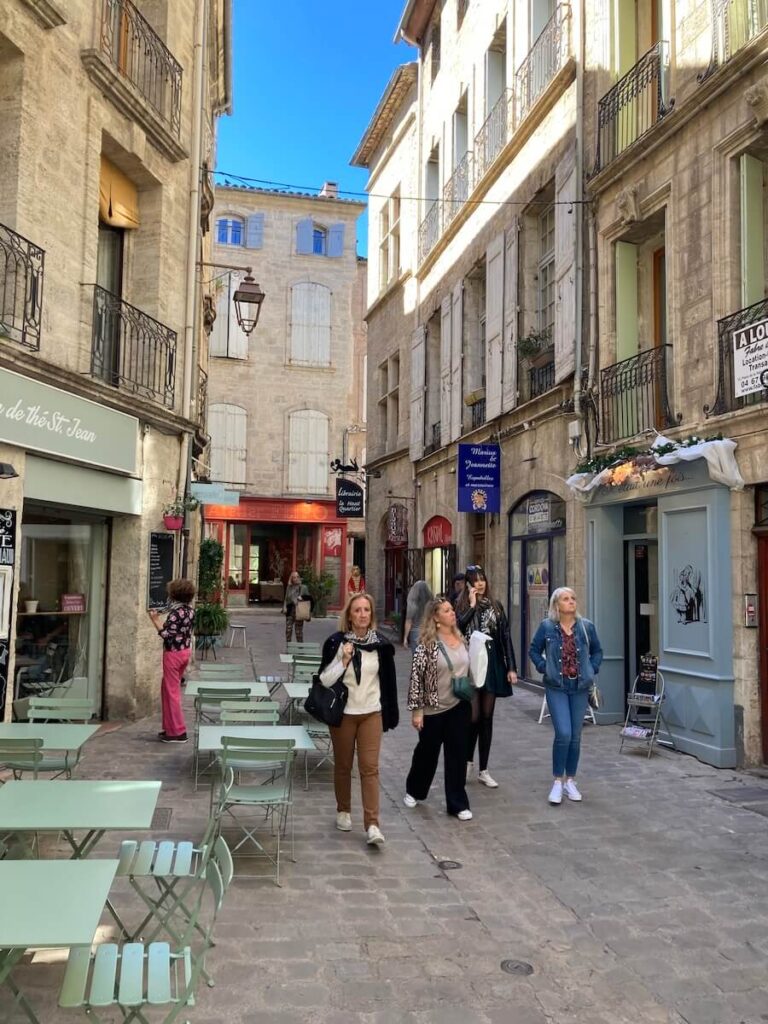
Pézenas is a perfect place to stroll—and shop, if the spirit moves you. * Photo: Karl Zimmermann
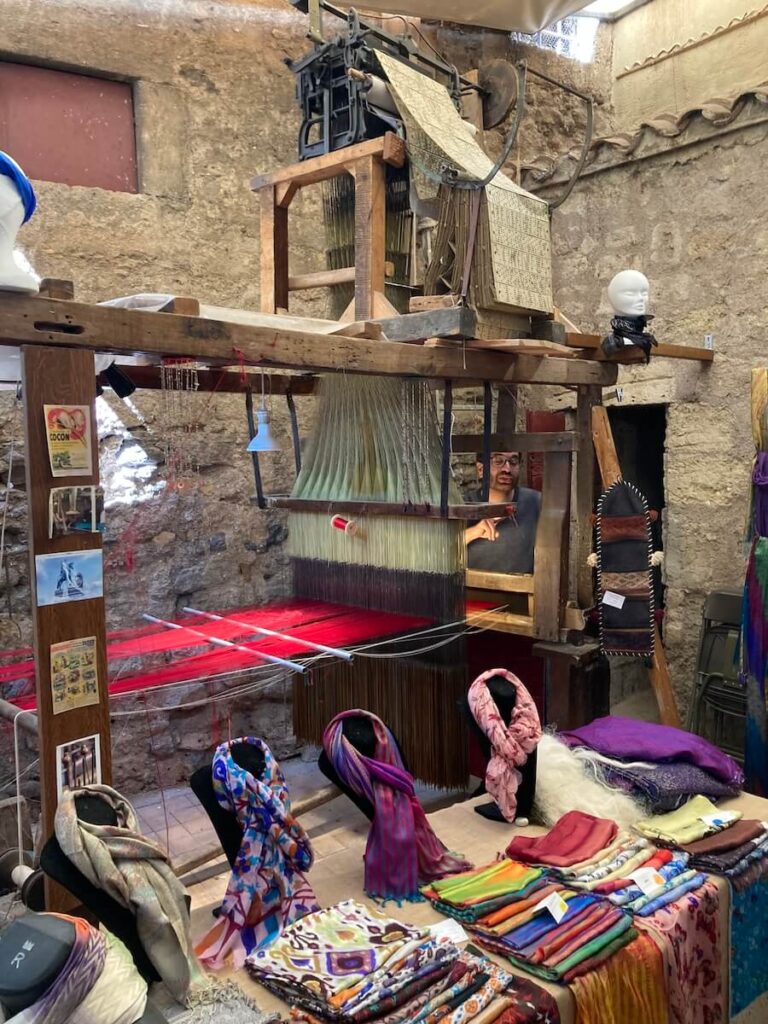
In Pézenas, the 15th Century Hotel de Lacoste houses an embroidery shop, where the proprietor works on an ancient loom imported from Eastern Europe. * Photo: Karl Zimmermann
That night was the farewell dinner, for which we dressed up — slightly. (Dress was typically completely casual.) The food was scrumptious, but then again it always was.

Our Farewell Dinner was exquisite, but it was virtually impossible for Toby to elevate a meal above what we’d been savoring all week. Left to right, Corey, Tracy, Karl and Laurel, and Cory and Nancy Brown, who runs her own travel website. * Photo: Roi Soleil Barge crew for Karl Zimmermann
“Low Bridge, Everybody Down!”
When Seppe called this from the wheelhouse to those of us who were getting situated on the raised forward deck, he wasn’t quoting a lyric from an old warhorse of a song about the Erie Canal but offering a genuine heads-up — or heads-down.
The canal is dotted with bridges, many historical and elegant architecturally, and many of them indeed low, and breathtakingly narrow. Though we knew Seppe would squeeze through even the tightest of them, sometimes we on deck burst into applause when we emerged unscathed.

This bridge is low enough to elicit a warning from Seppe, wide enough for him to breeze through, and elegant enough to do the builders of the canal proud. * Photo: Karl Zimmermann
Like Seppe, I found the canal endlessly fascinating. I grooved on every lock, locktender’s house, aqueduct, each different setting, mostly rural, each bend in the canal.
Though the tours were each special, I was always happy to be back aboard.

The Roi Soleil at La Croisade, “the crossroads,” in the backwoods setting that will always come to my mind when I recall our magical voyage on the Canal du Midi. * Photo: Karl Zimmermann
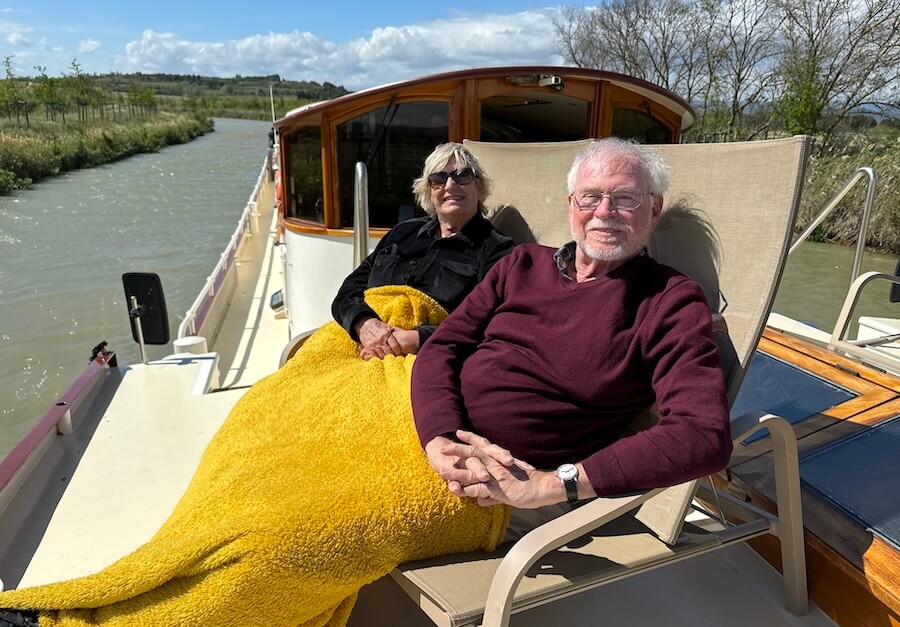
Laurel & Karl Zimmermann. * Photo: Roi Soleil barge-mate
Interested in this Roi Soleil Barge Cruise?
Our six-night Canal du Midi cruise in France was from Homps to Portiragnes, a distance of 70 kilometers (44 miles).
For the balance of the 2024 season, the six-passenger Roi Soleil is bookable only on a charter basis.
As with all Barge Lady offerings, fares include:
- all meals on and off the barge
- all beverages, including regional wines at mealtime and open-bar
- daily guided tours
- local transfers to/from the barge
Charter fares range from.$37,200 to $42,800 for six passengers depending on the season (which runs April through October). Though it was nippy at times during our April cruise, we were very happy to be sailing in shoulder season, when the canal was quieter. Keep in mind, the south of France can be hot in high summer.
For booking info, visit the Barge Lady Cruises website.
Enchante, a similar but slightly larger (eight passengers and a crew of five) Barge Ladies vessel on the Canal du Midi, is available individually on some dates at fares, depending on the season, of $7,550 to $8,590. Here’s more info.
Gratuities of 5 to 10 percent of the fare are suggested.
Getting There
Because it seemed to us a shame to be in France without spending at least a little time in Paris, and because we thought a few nights in Toulouse before the cruise would be a good way to recover from jet lag, we chose to fly to and from Charles de Gaulle in Paris, home to an on-site TGV rail station. Our fellow passengers flew to and from Barcelona. Their trip to and from Narbonne took about half the time of ours, and in retrospect that seems an excellent option.
In Toulouse, we stayed at the Ibis Toulouse Gare Matabiau, right across the square from the train station, as the name suggests, and were very pleased with it. Inside a classic exterior was a fresh, modern interior, and the breakfast was excellent. We had a good dinner at the restaurant in the hotel and the second night at Brasserie Bristol, right across the street from the Ibis. We dined outdoors, with a fine view of the historic Gare. The Canal du Midi flows under the square.
*Note: Topmost photo, like most of the photos in the story, was taken by Karl Zimmermann.
![]()
Don’t miss a post about small-ship cruising, subscribe to QuirkyCruise.com for monthly updates & special offers!
© This article is protected by copyright, no part may be reproduced by any process without written permission from the author. All Rights Reserved. QuirkyCruise.com.


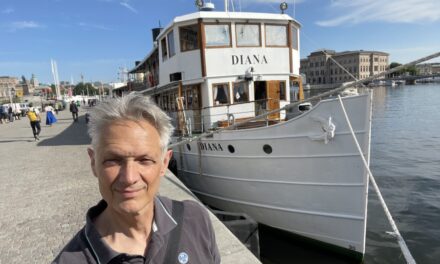
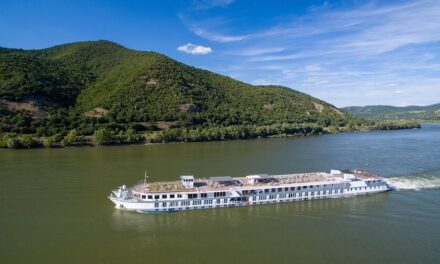
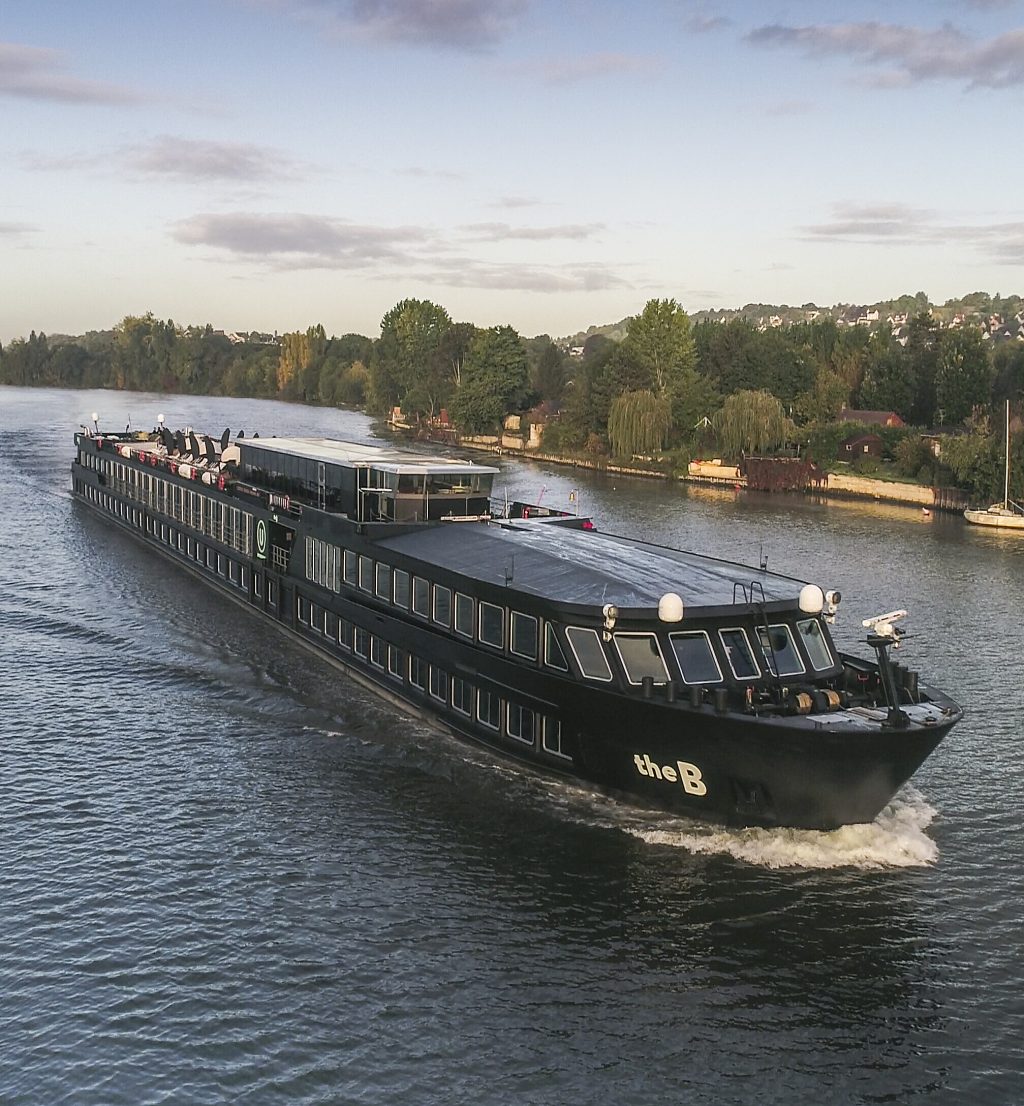
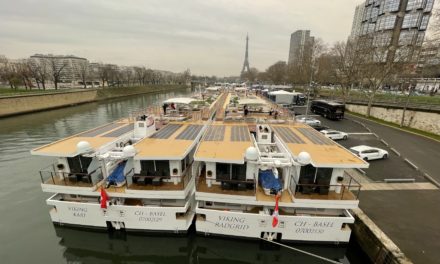








 HEIDI SARNA
HEIDI SARNA










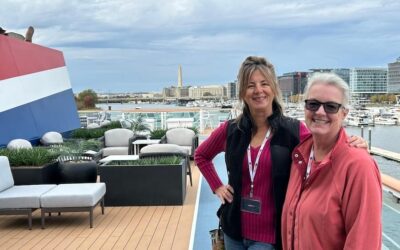

What a great read! Beautifully written and photographed by Karl, who has such an eye for detail and appreciation for all things nautical. His characterization of the crew and their esprits de corps was so vivid I felt like I know them.
Many thanks, Anne, for the kind words, which mean a great deal coming from you. It’s so gratifying that you responded to just the things I hoped a reader and viewer would notice. Perhaps some day we’ll be shipmates again!